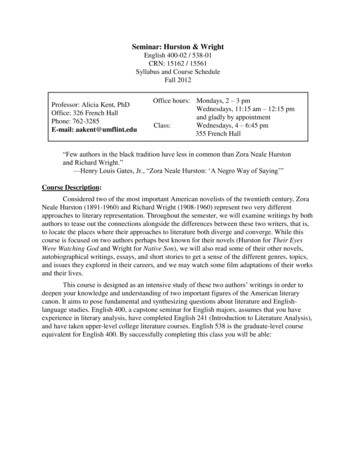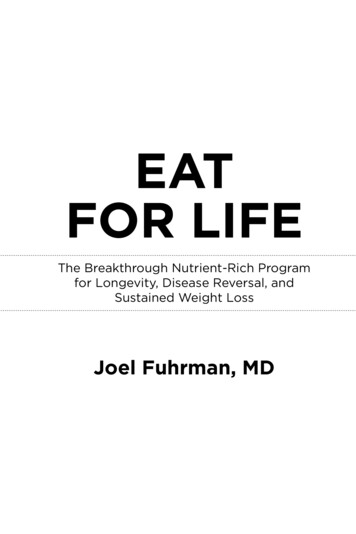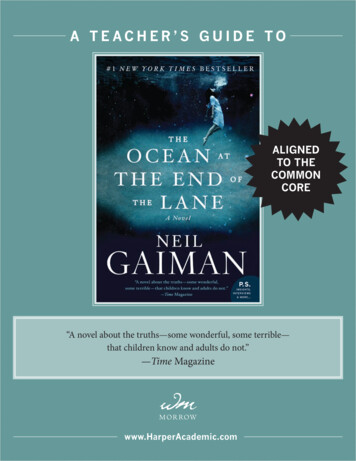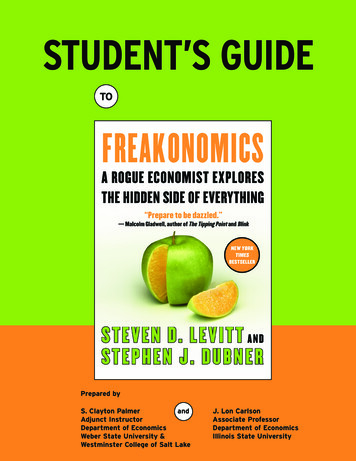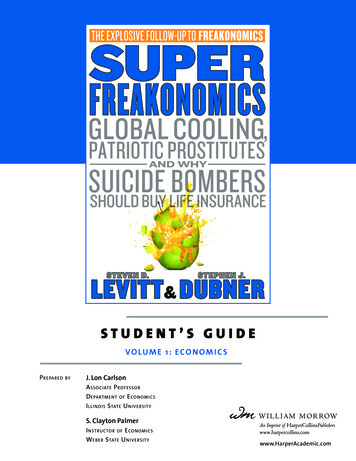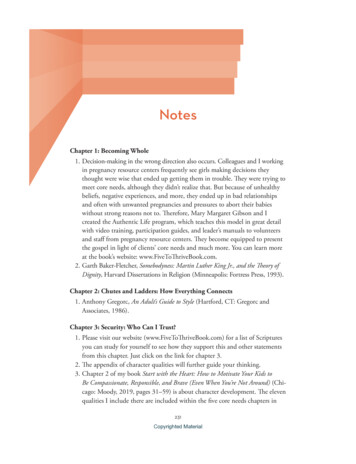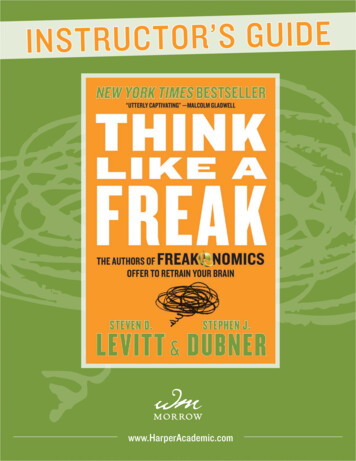
Transcription
IN S T R U C T O R ’S G UID Ewww.HarperAcademic.com
TH I N K LI KE A F REA K I n s tructo r ’s G ui de 2TABLE OF CONTENTSNote to Instructors3Before You Begin4Expanded Activity4Chapter One: What Does It Mean to Think Like a Freak?5Chapter Two: The Three Hardest Words in the English Language7Chapter Three: What’s Your Problem?9Chapter Four: Like a Bad Dye Job, the Truth Is in the Roots11Chapter Five: Think Like a Child13Chapter Six: Like Giving Candy to a Baby15Chapter Seven: What Do King Solomon and David Lee Roth Have in Common?17Chapter Eight: How to Persuade People Who Don’t Want to Be Persuaded19Chapter Nine: The Upside of Quitting21Expanded Activities23Books in the Freakonomics Series24About the Authors24
TH I N K LI KE A F REA K I n s tructo r ’s G ui de 3NOTE TO INSTRUCTORSThe purpose of this instructor’s guide is to provide additional opportunities for your students to understand andexplore what it means to think like a Freak.This guide can be used in classrooms or study groups. Instructors can choose to use the provided materials forsome or all chapters. The guide contains the following features:1. Chapter Summaries. These brief summaries review the main ideas of each chapter. They can be used beforeor after reading each chapter to preview (or review) the main ideas.2. Discussion Questions. Each chapter is accompanied by several discussion questions designed to reinforcethe main ideas from the chapter. The questions can be used to guide group discussions or can be answeredindependently.3. Activities. Activities for each chapter provide opportunities to apply thinking like a Freak to your students’lives.4. Expanded Activities. Several expanded activities are included at the beginning and end of the guide.Expanded activities require creative thinking and application of the principles from throughout the bookto solve problems, conduct research or share knowledge while thinking like a Freak.This guide was prepared by:Melissa Birkett Greene, Ph.D. Northern Arizona University K. Laurie Dickson, Ph.D., Northern Arizona University
TH I N K LI KE A F REA K I n s tructo r ’s G ui de 4BEFORE YOU BEGINConsider asking your students to complete this expanded activity before they read the book. We think it will helpthem to get the most out of their reading and thinking.EXPANDED ACTIVITYThe list below contains 6 key factors associated with thinking like a Freak. Before you learn about each of thefactors by reading the book, write down what you think each of these statements means.1. Be willing to say, “I don’t know.”2. Ignore boundaries.3. Think like a child.4. Incentivize people, but don’t manipulate them.5. Get your garden to weed itself.6. When facing a tough decision, flip a coin.After you finish reading the book, return to the list and modify your statements based on what you learned.Summarize how your thinking about problem solving has changed as a result of reading this book.
TH I N K LI KE A F REA K I n s tructo r ’s G ui de 51CHAPTER ONEWHAT DOES IT MEAN TO THINK LIKE A FREAK?CHAPTER SUMMARYWe are faced with questions everyday: Some are relatively easy to answer while others are complex and seeminglyunanswerable. Problems that linger are typically challenging to answer. If they were easy problems, they wouldalready be solved! Regardless of the size and complexity of a problem or task ahead of you, this book offers someadvice on how to think!Let’s explore what it means to “think like a Freak.” In many ways, thinking like a Freak encourages you to questioneverything, including things you already “know” to be true and even the very question you are asking. Scores of research studies have demonstrated that conventional wisdom is often wrong: just because people state somethingemphatically or believe it to be true; doesn’t make it true. Similarly, just because two events are temporally relateddoes not mean that one event or behavior caused the other event or behavior; correlation does not equal causality.Thinking like a Freak involves approaching problems and issues from different angles with different expectationsand without preconceptions and predetermined limitations. To do so, we need to rely on data to understand howthe world works, learn how incentives impact behavior, understand how resources are allocated, and explore obstacles to those resources.Sounds easy, right? If it is so easy and simple, why do so few people think like a Freak?Well, humans are funny that way. Our biases influence our thoughts and behaviors so that we seek out evidencethat confirms what we already think is true and discounts information that doesn’t.DISCUSSION QUESTIONS1. Given what you learned in this chapter, how would you describe what it means to “think Like a Freak”? Doyou think like a Freak? Why or why not? Would you encourage others to think like a Freak? Why or why not?2. If “Thinking Like a Freak” is so easy and simple, why do so few people think like a Freak?3. Using the soccer example from Chapter 1, if you were taking a penalty kick, explain your strategy for kickingthe ball. Does your explanation make sense to someone who is thinking like a Freak? Why or why not?4. When faced with a problem, do people tend to act to support the greater good or focus more on private benefit? Why?5. Where do people get their biases and “knowledge”? How do our interactions with family and friends reinforceour biases and “knowledge”?6. Describe the economic approach. Do you tend to approach problems using this approach? Why or why not?7. Imagine that you were charged with reducing the use of disposable plastic water bottles that Americans use.How would you use utilize the economic approach to solve this problem?8. Why is it important to understand the role of specific incentives when trying to solve a problem?9. People often do not want to challenge others’ ideas, even if they have evidence that the ideas are incorrect,because it would be uncomfortable. Americans, more than others, tend to support the notion that people canhave their own ideas. Why do you think this is the case?
TH I N K LI KE A F REA K I n s tructo r ’s G ui de 61ACTIVITIES1. Take a quick poll of your friends’ and family members’ position on one of the following current issues: globalwarming, vaccination, abortion, gun control, prayer in school or car seats. How many have the same “answer”or opinion? Did you observe any trends, consistencies or inconsistencies? Are your opinions similar or differentfrom your family and friends? Did you avoid picking any of these issues because of the strong opinions thatyour family and friends have on these issues? Why do you think you did this?2. In psychology and cognitive science, confirmation bias (or confirmatory bias) is a tendency to search for orinterpret information in a way that confirms one’s preconceptions. Provide an example when you engagedin this type of thinking and when you did not fall into the “trap” of confirmation bias. Now, think about thesetwo situations, why do you think you fell into the “trap” of confirmation bias in one of the situations and notthe other one? What factors influenced your thinking?
TH I N K LI KE A F REA K I n s tructo r ’s G ui de 72CHAPTER TWOTHE THREE HARDEST WORDS IN THE ENGLISH LANGUAGECHAPTER SUMMARY“I don’t know” are the hardest three words for adults to say. Why does it matter that people have trouble admittingthat they don’t know something?If you already know the answer, you won’t continue to look for an answer. Until you can admit what you don’t yetknow, it’s nearly impossible to learn what you need to know, which can be a problem!Our thinking about issues and problems is often influenced by our biases and our “moral compass,” the internalthinking about the difference between right and wrong. Our moral compass can overshadow our understanding ofthe issue or problem at hand by convincing us that the answers are obvious. In a sense, assuming there is a cleardistinction between right and wrong can prevent you from learning more about the issue because you think youalready know it all!Thinking like a Freak provides an approach to problem solving that minimizes the influence of biases and moralcompasses. Thinking like a Freak involves answering questions, trying out new ideas, being open to feedback, andchallenging prevailing orthodoxies partly because it results in more productive and creative answers to seeminglyunanswerable questions. It is a little less scary to say “I don’t know” if you follow that statement with “but maybeI can find out!”DISCUSSION QUESTIONS1. Explain Daniel Patrick Moynihan’s famous quote: “Everyone’s entitled to their own opinion but not to theirown fact.” How did you respond to this quote? Did you agree with it? Why or why not?2. Describe the findings from the global survey research that examined people’s thoughts about whether ornot the devil really exists. What evidence is presented to support the assertion that political or religious viewsinfluence people’s beliefs about whether the devil really exists?3. Why do Levitt and Dubner want you to “put away your moral compass”? How do you think your best friendwould react if you encouraged her to put away her moral compass? How would you respond?4. Explain the “no one left to blame” theory of suicide. What evidence supports this theory and what evidencedoes not? Have your biases or moral compass influenced your interpretation of the research?5. Explain how an experiment would have helped the multinational retailer better understand the impact of theinvestment in US advertising.6. Why do Levitt and Dubner encourage people to conduct experiments to help solve problems?7. Provide some examples of issues/problems where a “true” experiment could not be conducted. Be sure to explain the reasons for your answer. If a true experiment couldn’t be conducted, how could thinking like a Freakstill help?8. Explain the wine experiment. What made this an experiment? What were the findings?
TH I N K LI KE A F REA K I n s tructo r ’s G ui de 82ACTIVITIES1. Problems that we face today, such as climate change, terrorism, and mass shootings cannot be answeredby simply assembling facts; they require judgment, intuition, and an educated guess about how thing willultimately turn out. Thus, to address complex problems, we need to make educated predictions based on scientifically verified facts. If everyone has access to the same scientifically verified facts, everyone should comeup with the same solution, right? Why or why not?2. To highlight the influence that political views can have on people’s opinions, list a couple of your opinions thatmay be sculpted by your political views. Next, talk with at least two people who have a different political affiliation than you. Are their opinions on those same issues similar to yours or different? Reflect on the role thatpolitical affiliation has on yours’ and others’ opinions? Summarize your experience with these conversations.3. Given the tendency to want to protect our own reputation, people often perceive that the cost of saying “Idon’t know” is higher than the cost of being wrong—at least for the individual. Imagine that you are the CEOof a large corporation. Outline a strategy that you would use to counteract this tendency in your business.
TH I N K LI KE A F REA K I n s tructo r ’s G ui de 93CHAPTER THREEWHAT’S YOUR PROBLEM?CHAPTER SUMMARYOftentimes, we are so focused on finding the right answer that we don’t stop to think whether we are asking theright question. Taking the time to determine if you should be asking a different question could save time and effortin the long run because if you ask the wrong question, it is likely that you will get the wrong answer!When thinking about education reform issues, Levitt and Dubner posit that we should reframe the question from“what’s wrong with our schools?” to “what other factors related to home environments impact kids’ performancein schools?” In solving education reform problems, maybe we are focused too much on schools and the teachers,and too little on parents.Whatever problem you are trying to solve, make sure that you’re not just “trying to solve” the noisy part of theproblem. Don’t fall victim to the squeaky wheel gets the attention dilemma.Takeru Kobayashi, better known as Kobi, revolutionized hotdog-eating contests, by redefining the problem hewas trying to solve; he approached the “problem” differently. Instead of asking “how can I eat more hotdogs?”, heasked “how do I make hot dogs easier to eat?” Rather than focusing on speeding up the process of eating a hotdogand bun in the traditional manner, he broke the hot dog in half and soaked the bun in liquid to reduce how muchhe would have to chew! Like a true Freak, Kobi continued to experiment with variations, such as wiggling as he atein order to make more room in his stomach. Using feedback from his experiments, he modified his approach witha different set of solutions.In addition to redefining the problem he was trying to solve, Kobi questioned the assumed “limits” or “barriers” tothe problem—in his case the number of hot dogs a person can eat in 12 minutes. The assumptions that we makebased on familiar expectations and past behaviors can limit us. The authors note that “solving a problem can behard enough, it gets much harder if you’ve decided beforehand it can’t be done!”DISCUSSION QUESTIONS1. Explain why reframing the question can help you solve a problem.2. Do you agree that when we discuss how well American children are doing in school, we should consider therole of parents as well as the role of teachers and schools? Explain your reasoning.3. Is it always problematic to focus on the “noisy” part of the problem or issue? Describe incidences when it isbeneficial and incidences when it is problematic to focus on the noisy part of the problem. Explain the factorsthat influence the part of the problem that people tend to focus on.4. Explain how Kobi redefined the problem of competitive hotdog eating. How did redefining the problem helphim solve his problem?5. Describe the strategies that Kobi came up with that resulted from his redefined problem.6. Describe the role that experimentation played in Kobi’s success.7. Describe the two broad lessons that you learned from Kobi’s experience as a world famous hotdog-eatingchampion. Apply these lessons to a situation that you are currently facing.8. Roger Bannister was the first human to run a sub-four-minute mile. What did he mean when he said “It is thebrain, not the heart or lungs, that is the critical organ”?
TH I N K LI KE A F REA K I n s tructo r ’s G ui de 10 39. Do you think that Levitt and Dubner would encourage people to have the courage to ignore limits? Why orwhy not?ACTIVITIES1. Provide an example from your life, when you focused your attention on the “noisy” part of the problem. Howcould you reframe the problem/question to facilitate a true resolution to the problem? What factors influenced your decision to focus on that part of the problem?2. Provide an example from your life, or someone you know, that highlights the role that “assumed limits orbarriers” have on behavior. Examples include financial limits, temporal or time limits, expectation limits, socialacceptability—what is cool to say or not to say. Explain how these false limits may be impeding your socialinteractions, success, happiness, etc.
TH I N K LI KE A F REA K I n s tructo r ’s G ui de 11 4CHAPTER FOURLIKE A BAD DYE JOB, THE TRUTH IS IN THE ROOTSCHAPTER SUMMARYThinking like a Freak means identifying the root cause of a problem, rather than attempting to build solutions thatfocus on obvious, though often incorrect, “causes.” For a variety of reasons, root causes are often not apparent orpalatable, thus we often focus on treating the symptoms or behaviors that we think are the cause because theyare right there in front of us. In this chapter, the authors take us on a journey back in time and around the world toshare examples of non-obvious root causes.First, through the exploration of numerous theories that have been put forth to explain the rise and fall of violentcrime in the United States, we learn that the number of unwanted children may be a primary factor. Second, exploring the role of 16th-century religious decisions in current economies highlights that root causes may go backseveral generations. Likewise, contemporary patterns of participation in civic and philanthropic programs in several Italian towns may stem from their history as either a free-state or governed overlord state. We also learn thatcolonial focus on establishing colonies based on land mass and water, without attention to the ethnic distributionof indigenous people, may be a root cause in current patterns of ethnic strife and conflict in Africa. Finally, RolandFryer, an economist from Harvard, found that a selection mechanism of the slave trade could be the long-lastingroot cause of higher rates of heart disease among African Americans.The two remaining examples in this chapter take us on a journey of the human body. Barry Marshall’s method ofdiscovery of the root cause of ulcers was a bit unorthodox; he ingested the suspect bacteria to verify that it wasthe cause of ulcers and that antibiotics would cure the resulting ulcer. Fortunately, he was correct! Building on the“self as lab rat” method of discovery later led Australian physician Thomas Borody to discover the unlikely powerof poop!DISCUSSION QUESTIONS1. Explain how thinking like a Freak is “like a bad dye job.”2. Explain why problems are more likely to be resolved when causes, not symptoms, are addressed. Providean example from your community that highlights a situation when symptoms are being targeted insteadaddressing root causes.3. Why would a Freak consider the lack of food and money to be a superficial answer to the question of thecauses poverty and famine?4. What role did the legalization of abortion in the early 1970s play in the rise and fall of violent crime in theUnited States? Was it the root cause? Explain.5. What factors did German economist Spenkuch find to account for the Protestant-Catholic income gap inGermany? How do these factors relate to the concept of a Protestant work ethic?6. What role did the illustration titled “An Englishman Tastes the Sweat of an African” have in economist Fryer’ssearch for the root cause of African-American’s higher rate of heart disease?7. Using Barry Marshall’s study of the causes of ulcers, convince your grandmother that stress and spicy food donot cause ulcers.8. Discuss which characteristics of thinking like a Freak Barry Marshall and Robin Warren engage in as theystudied the causes of ulcers.9. What does the saying “power of poop” mean?
TH I N K LI KE A F REA K I n s tructo r ’s G ui de 12 4ACTIVITIES1. Think about the current obesity epidemic in the United States, and provide three examples of “solutions” thataddress the symptoms. Have they been successful? Why or why not? Thinking like a Freak, identify possibleroot causes of the obesity epidemic.2. Watch the TED talk focused on obesity by Peter Attia. Applying the lessons learned from this chapter andprevious chapter, explain how redefining the problem, ignoring limitations, and searching for the root cause ishelping us better understand the obesity crisis.
TH I N K LI KE A F REA K I n s tructo r ’s G ui de 13 5CHAPTER FIVETHINK LIKE A CHILDCHAPTER SUMMARYHow can problem solvers benefit from thinking like eight-year-olds? Are eight-year-olds smarter than adults? No,but they tend to approach problems differently.Thinking like a child means asking a lot of questions and generating a lot of ideas—especially outlandish, silly, orobvious ones. Children aren’t afraid to come up with wild ideas, and thinking like a Freak means you shouldn’t beeither! Not every new idea has to be a winner, but if you can sort the good from the bad, you may find yourselfwith some Freakishly good ideas. Remember, throwing out bad ideas is easy and doesn’t cost a thing. Finding agood idea can be priceless.Thinking like a child means thinking small, not big. This chapter offers four reasons to think small:1. The small questions haven’t all been asked yet (you can be a pioneer!).2. Working on a small piece of a big problem is easier than taking on a larger, more complicated problem.3. Small changes arise from thinking small and are more likely to be successful than larger and more difficultchanges.4. Thinking small is more precise and holds lower stakes than thinking big.Thinking like a child also means having fun. Kids do the things they like to do. When you’re doing what you enjoy,it’s easier to persist in your efforts to think like a Freak and persevere in your problem solving efforts.DISCUSSION QUESTIONS1. Do you think like a child in your own life? Describe examples of situations that required you to think like achild. What were the outcomes?2. This chapter suggests four reasons to think small. Choose a pressing problem facing you or your communityand explain how each of these reasons to think small could help you solve the problem. For example, youmight consider thinking small about low graduation rates, food insecurity, or access to health care.3. Barry Marshall was a “simple” guy whose childhood experiences and ability to continue to think like a childhelped solve the mystery of where ulcers come from and how to effectively treat them. How did thinking likea child influence Marshall’s view of the human body and contribute to him asking obvious (and important!)questions?4. “Kids are in love with their own audacity, mesmerized by the world around them, and unstoppable in theirpursuit of fun” (p. 96). How does this quote represent the benefits of thinking like a child? How could the ideasexpressed in this quote contribute to logging the hours required to become an expert at something?5. The authors ask, “Why is it so important to have fun?” (p. 96). Thinking like a Freak, what would your answerto this question be?6. Why is it harder for magicians to fool kids than adults? What about children’s thinking that makes them lesssusceptible to fall for a magic trick?7. Malala Yousafzai was only seventeen years old when she was awarded the Nobel Peace Prize in 2014 as theyoungest recipient in the history of the award. Watch a video or read a transcript of her Nobel Lecture. Howdoes she use (or not use) examples of thinking like a child in her approach to problem solving?
TH I N K LI KE A F REA K I n s tructo r ’s G ui de 14 58. In this chapter, the authors share several examples of small thinking that had big impacts, such as researchon drunk walking and stealing at bagel shops. In another example, thinking small resulted in a 25-50% increase in test scores for Chinese students—all for only about 15 per student. Select one of the examples fromthis chapter and describe how small thinking saved the day and solved the problem.ACTIVITIES1. To better think like a Freak, this chapter suggests a three-step process to get started on problem solving: (1)generate a big list of ideas (especially obvious or outrageous ones), (2) follow this step with a cooling off period (sleep on it), and then (3) finally sort the good ideas from bad (remember it costs nothing to ditch a badidea). It’s time to try this strategy in your own life! Choose a pressing issue in your own life, generate a list ofideas, give them a waiting period, and finally, identify the best ideas from your list. Describe your experiencewith this process and reflect on it.2. Use thinking like a child and having fun to solve a problem (preferably a small problem!). Identify a problembehavior that you or a person you know would like to change. Think about the “fun” part of the behavior.Describe a strategy to change the problem behavior to a beneficial behavior using a fun approach. Examplesfrom the book include using a lottery to increase savings and a social gaming site to raise money for charity.Hint: You might even think back to previous chapters that include discussion of incentives.
TH I N K LI KE A F REA K I n s tructo r ’s G ui de 15 6CHAPTER SIXLIKE GIVING CANDY TO A BABYCHAPTER SUMMARYWould you complete your homework assignments if they didn’t have grades? How about working at your job ifyou weren’t being paid?Are incentives powerful motivators or simply bribes? This chapter contains examples of the effective (and ineffective) use of incentives—from M&M’s to fines for hit-and-run accidents—in an attempt to answer this question.Thinking like a Freak entails effectively using incentives to change behavior. Again, sounds simple, right? Unfortunately, finding the right incentive, in the right amount, at the right time, under the right circumstances can bechallenging.Adding to the challenge, people’s preferences for incentives are not always clear. In many circumstances peoplesay one thing but do another. Being able to observe people’s behavior and determine the incentives that reallymotivate their behavior can help you in many situations. For example, understanding the true incentives for behavior change helped researchers reduce energy consumption in California and theft in Arizona as well as increasecharitable donations.This chapter offers three reasons why incentive-based plans can fail. Thinking like a Freak means understandingthe limits of incentives and the distances some individuals may be willing to go to get around your incentivizedplans.Finally, changing the frame of a relationship can be a powerful tool in changing behavior, too. Examples of changing relationship frames range from the surprising successes of a ping pong team as an agent of internationaldiplomacy and the unlikely rise of Zappos to become a leader in the online marketplace.DISCUSSION QUESTIONS1. The title of this chapter, “Like Giving Candy to a Baby,” hints at an experience one of the authors had withincentives used to change behavior. How can incentives be effective changing behavior? Do incentives alwaysproduce the desired behavior? Why or why not?2. Effectively using incentives means understanding what they are. List examples of financial, social, moral,legal or other kinds of incentives and describe how they might work in one setting and backfire in another.3. In this chapter, Levitt and Dubner explore the relationship between cheap food and obesity. Using this example, propose how incentives could be manipulated to attempt to ameliorate the obesity epidemic in the US.4. Many educators and economists disagree about providing cash incentives for children to perform well inschool. Explain perspectives for and against the use of pay for grades.5. This chapter introduces the concepts of declared preferences and revealed preferences. Explain the differencebetween these and offer examples of these two types of preferences that you have observed in your ownexperience.6. Summarize the differences between the declared and revealed preferences of participants in the study ofincentives for energy conservation in California, or the study of petrified wood theft from a national park inArizona, or the once-and-done donor recruitment strategy of Smile Train.7. Using examples from your own life, describe two or more relationship frames that influence your behavior.
TH I N K LI KE A F REA K I n s tructo r ’s G ui de 16 68. What are three reasons why even carefully constructed incentive plans can fail? Describe an example of a realor fictional incentive plan failure due to these reasons.ACTIVITIES1. Think about a problem you are currently facing at home, work or school. Hint: Recall from the previous chapter that there are benefits to focusing on a small problem. How could incentives help you to solve this problem? Create an incentive plan for changing a behavior to help solve your problem by addressing the six rulesof incentives on page 135.2. Remember the pay for grades example from page 109? Imagine that wealthy philanthropists have read thisbook and want to pay students a substantial amount of money for high grades. This should universally workto improve student success, right? Are you skeptical? You should be. Consider the perspective of a sneaky student with ambiguous morals. How might he/she vie
Let’s explore what it means to “think like a Freak.” In many ways, thinking like a Freak encourages you to question everything, including things you already “know” to be true and even the very question you are asking. Scores of re-search studies have demonstrated that conventional wisdom is often wrong: just because people state somethingFile Size: 2MBPage Count: 24



